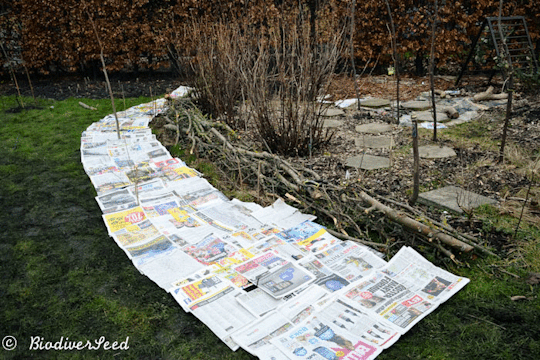

There are few places in the natural world—short of deserts, beaches and rocky landscapes—where the earth stands bare and exposed. Generally, soil wants to be covered.
The plants that many of us call “weeds” in the garden are those plants that are successful at colonising and covering bare soil. Often they’re the hardiest, most efficient plants from the local ecosystem, with either long taproots; fibrous, deep-penetrating root networks; and/or minimal water and nutrition needs. When soil is disturbed from weeding or tilling, these plants rush in, or spring from the soil seed bank, in order to fill in the blanks. Therefore, in covering up the soil, weeds provide ecological services: They shade and cool the soil, which helps reduce evaporation, while their foliage traps humidity at the ground level.

Sheet mulching—aka, using successive layers of biomass to cover the soil—is a permacultural gardening technique that mimics the ecological services weeds provide, while suppressing their growth. Sheet mulches create a rich, non-disrupted soil ecosystem where mushroom mycelium can run and decomposers, detritus-feeders and soil-dwelling organisms can exist without interference. Current soil science recognizes these organisms as part of a vital web of soil life— one that is disrupted through tilling, which ultimately leads to soil depletion.

A sheet mulch can consist of a thick layer of cardboard or newspaper with soy-based inks, manure or compost, grass clippings, seaweed, leaves, straw, or bark chips. As with compost, it’s important to consider the carbon to nitrogen ratio of your soil. Generally, sheet mulch will fare better if it’s high in carbon, consisting mainly of “browns” like cardboard, dead leaves, straw and wood chips, as thick layers of “greens” tend to form anaerobic mats. Desired plants can be top-worked or drilled from above. All of their nutrition needs will be provided by the mulch, which will in turn hold water like a sponge and suppress the growth of competitor plants.
Over time, successive sheet mulches build a rich humus soil and can divert almost all paper, cardboard and yard “waste” to soil-building material, all the while reducing the amount of time spent weeding, watering and fertilizing.





One reply on “UF Hack: Improve Soil With Sheet Mulch”
[…] layers of different mulches—called “lasagna gardening” or sheet mulching—can create a layer of organic matter that combines the qualities of several of these potential […]